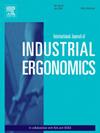Effect of physical exertion on workers safety awareness: A biosensing and eye-tracking study
IF 2.5
2区 工程技术
Q2 ENGINEERING, INDUSTRIAL
International Journal of Industrial Ergonomics
Pub Date : 2025-04-04
DOI:10.1016/j.ergon.2025.103737
引用次数: 0
Abstract
Construction's unique occupational health and safety challenges manifest from workers' exposure to stressful and hazardous conditions, impairing their cognitive abilities to identify and eliminate risky situations. Physical stress imposed as physical exertion is a major workplace stress category that impacts construction workers' safety behavior. While previous studies have demonstrated the effect of physical exertion on workers' hazard recognition and safety performance, research gaps persist regarding the direct impact of physical exertion on workers' physiological responses and near-miss recognition performance. This study investigates workers' ability to recognize near-miss incidents using an eye-tracking experiment conducted in controlled non-stress and physical stress (overexertion) conditions. Thirty-five participants were exposed to near-miss scenarios from construction sites. Physiological and eye-tracking matrices measured their bio signals and safety behavior during the experiment. The findings from this study reveal that physical overexertion triggered by manual material handling activity can adversely affect worker safety behavior and cognitive ability toward near-miss recognition. Visual attention toward near-miss scenarios was reduced by 39.43 % post-exposure to physical exertion. Additionally, physiological data collected using wearable sensors shows a significant statistical association with near-miss recognition of participants. Individuals with low neuroticism and extraversion showed the highest reduction in recognition performance post-exposure to physical exertion. The study confirms the significant impact of fatigue on reducing workers' efficiency in identifying near-misses, suggesting avenues for developing overexertion relief assessment systems using wearable sensors. Additionally, personality-based safety worker allocation models could aid in recruiting and training workers with lower recognition abilities.
体力消耗对工人安全意识的影响:一项生物传感和眼动追踪研究
建筑业独特的职业健康和安全挑战体现在工人暴露于压力和危险的条件下,损害了他们识别和消除危险情况的认知能力。体力消耗造成的体力压力是影响建筑工人安全行为的主要工作场所压力类别。虽然以往的研究已经证明了体力消耗对工人危险识别和安全绩效的影响,但关于体力消耗对工人生理反应和近险识别绩效的直接影响,研究空白仍然存在。本研究通过在受控的无压力和身体压力(过度劳累)条件下进行的眼动追踪实验,调查了工人识别未遂事件的能力。35名参与者暴露在建筑工地的惊险场景中。生理和眼动追踪矩阵在实验过程中测量了它们的生物信号和安全行为。本研究结果表明,体力搬运活动引发的体力过度消耗会对工人的安全行为和对侥幸识别的认知能力产生不利影响。暴露于体力消耗后,对未遂事件的视觉注意力减少了39.43%。此外,使用可穿戴传感器收集的生理数据显示与参与者的近靶识别有显著的统计关联。低神经质和外向性的个体在体力消耗后的识别能力下降幅度最大。该研究证实了疲劳对降低工人识别未遂事故的效率的重大影响,为开发使用可穿戴传感器的过度劳累缓解评估系统提供了途径。此外,基于人格的安全工人分配模型可以帮助招聘和培训识别能力较低的工人。
本文章由计算机程序翻译,如有差异,请以英文原文为准。
求助全文
约1分钟内获得全文
求助全文
来源期刊
CiteScore
6.40
自引率
12.90%
发文量
110
审稿时长
56 days
期刊介绍:
The journal publishes original contributions that add to our understanding of the role of humans in today systems and the interactions thereof with various system components. The journal typically covers the following areas: industrial and occupational ergonomics, design of systems, tools and equipment, human performance measurement and modeling, human productivity, humans in technologically complex systems, and safety. The focus of the articles includes basic theoretical advances, applications, case studies, new methodologies and procedures; and empirical studies.

 求助内容:
求助内容: 应助结果提醒方式:
应助结果提醒方式:


